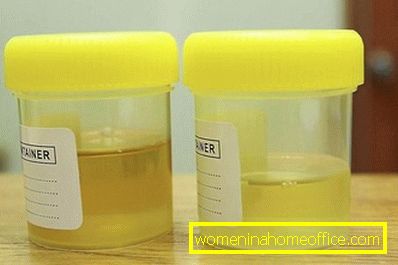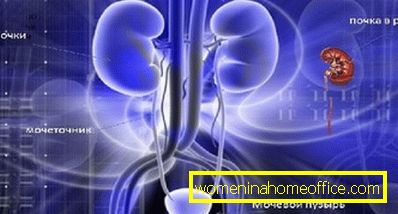Turbid urine in a child
Urinary tract infection (UTI) in children is an inflammatory condition caused by the presence of bacteria (minus viruses or fungi) in the urinary tract. A common symptom of this disease may be turbid urine.
The most common route of infection is the urinary canal, bladder, ureters, and kidneys. But in newborns and babies there is a risk of infection through blood products. 85% of UTIs in children cause E. coli, bacteria that inhabit the gastrointestinal tract. More prone to girls imp. The recurrence of the disease may indicate defects in the urethra or bladder, as well as dysfunction.
Turbid urine in a child: causes

The urine of the child should be transparent, light straw color. Sometimes, as a result of consuming certain foods or taking medicine, it changes shade. Urine may have a dark shade, be tinged with blood or cloudy. If this condition persists for at least 2 days, you must show the child to the doctor.
Why does the baby have turbid urine? - this question is often asked by parents. The answer is simple - a sign of urinary tract infection:
- Urine changes color and acquires a peculiar unpleasant odor due to the presence of bacteria, salts, fats, red and white blood cells, and mucus. Transparent dark brown urine is a sign of liver dysfunction, acute hepatitis or cirrhosis.
- Urine can change color from the use of beets, berries or other foods of bright color, to get the color from pink to light brown. But this color may indicate nagemolytic anemia, renal trauma injuries. It may be a specific reaction to medication, porphyria, or urinary tract disorder that causes bleeding (cystitis, an enlarged prostate, a bladder tumor or kidneys, tuberculosis, bladder stones, infections of the kidneys).
- From taking vitamins and some drugs, the color is from dark yellow to orange. Sometimes urine may be greenish or blue. This is due to the use of artificially colored products, as well as the presence of bilirubin, urinary tract infection, and also taking medications containing blue methylene.
- Sometimes the cause of turbid urine may be too long holding it in the bladder.
A visit with a child is required if:
- the color of urine is uncharacteristic, and you cannot determine the cause, there is blood in the urine;
- the urine is clear and dark brown, the child is lethargic and has yellow skin and yellow whites of eyes, pale stools;
- if the child has turbid urine with sediment;
- urine is pink, red, or brownish, but not due to the consumption of certain foods or drugs.
Infection of urinary tract in children

The urinary tract is the organ that is responsible for the production and removal of urine from the body. The urinary tract includes the kidneys, bladder and ureters. When bacteria enter the urinary tract, they can lead to infection. In children, as a rule, they pass very quickly after the start of therapy. Failure to take proper measures, however, may result in permanent damage. This can cause impaired renal function, or even the loss of its efficiency. Infections can cause a serious illness known as sepsis of the body.
Symptoms of the disease
In the case of young children and infants, it is not easy to determine the presence of infections. Toddlers can't tell if they feel pain or burning when they urinate.
In this situation, parents should be vigilant and do not underestimate the following symptoms:
- fever of unknown cause (not caused by influenza or another disease);
- unpleasant smell of urine;
- abdominal pain and soreness;
- lack of appetite;
- diarrhea;
- vomiting and irritability in a child.
If a turbid urine in a child is 3 years old, then he often has:
- pain or burning when urinating;
- increased bowel movement;
- loss of urinary control;
- urine of unusual color;
- urine smells like ammonia;
- fever;
- chills;
- backache or pain in the lower abdomen.
For the diagnosis, it is necessary to study the child’s behavior and determine the alarming symptoms. To do this, examine the urine of the child. Waiting for the results, which takes usually 1-2 days, but before the results are obtained, the doctor prescribes drugs, as a rule, to fight the infection.
What and how to treat the disease?

- Urinary tract infections are treated with antibiotics. Parents should follow the instructions of the doctor and not interrupt the treatment when the baby feels a little better.
- The length of antibiotic therapy depends on the disease, the patient's age and the type of drug.
- During treatment, the patient should rest and consume plenty of fluids. In the process of treatment should be frequent urination.
- If within 2 days, the condition does not improve, you should turn to the law. May have to change the drug.
The diagnosis of UTI is based on the results of a child’s examination and additional tests: general analysis, urine culture and peripheral blood morphology (high white blood cell count, altered number of white blood cells), increased ESR and increased C-reactive protein (CRP) levels in the blood. In children, especially with UTI and high white blood cell count, an abdominal ultrasound scan should be performed.
Other studies of the urinary tract to determine the condition and function of the bladder (vascular cystography) and kidney (scintigraphy) should be prescribed by a physician, pediatric nephrologist.
Parents should closely monitor the health of the child, including the color of his urine. Changing this fluid in color or consistency can indicate a serious illness. This is a reason to immediately contact your doctor.